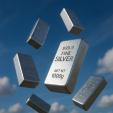Tariff Threat Makes Gold Market Go Haywire
Tariffs are in the air, with different industries and countries in President Trump’s crosshairs. On Thursday, August 7th he declared that imports from Switzerland would be subject to a 39% tariff.
That same day, a ruling letter from the US Customs and Border Protection came to public attention that 1kg and 100oz gold bars are subject to tariffs. A COMEX futures contract is 100oz, so a contract is satisfied by delivery of either one 100oz bar or three 1kg bars.
The gold market blew up.
Stop focusing on prices
Before we get into what happened, let’s look at what did not happen. The price did not crash, and the price did not skyrocket.
Most analysis tends to focus on the price action, but in many cases this looks past the real action. On Thursday at midnight, the gold price (this is spot, not futures) was about $3,385.
On Friday, when markets closed for the weekend, it was a little more than $10 higher. In the middle, it had been about $15 higher than that, and as low as around $3,360. This price movement, like most days, is essentially random. $50 total range is less than 1.5%. This is hardly worth a comment.
The real action occurred—as it often does—in a spread.
Gold spread explodes
In the past I’ve written many articles about one spread in particular. The gold basis. It is futures price – spot price. When this spread is positive—as it almost always is—then one can make a profit by buying physical metal at the spot price and simultaneously selling a futures contract. The cost for the trade is storage + interest expense to finance the gold metal.
I typically write about this spread to analyze the abundance or scarcity of metal, and hence to get a sense of where the price is likely to move next. But now, this spread is showing something else entirely.
The cost of bringing gold to deliver to COMEX went way up. How much? Let’s look at a graph of the basis for the October contract, showing just the latter part of the week.
October gold basis overlaid with gold price, August 6-8th 2025
The gold basis is humming along around 3.5%, prior to ruling letter. This level is no coincidence; it is around the level of the 2- and 3-month Treasurys. If it gets much above this, it’s worth somebody’s while to sell a few Treasurys (or repo them) and put the capital into the gold carry trade.
But then, suddenly the gold carry trade may not be viable. Gold is produced and refined domestically, but much of the gold delivered to COMEX comes from Switzerland.
With a tariff rate of 39%, it hardly pays to bring gold to the US for 3.5%. And keep in mind the tariff is not an annualized rate; it’s an up-front cost. Whereas the basis is an annualized rate (divide by about 6 for the October contract, which delivers in around two months).
As they say in New York “fuhgeddaboudit!”
The decarry trade
What do you do if you are carrying gold—long spot, short futures? You decarry it. That is, you sell the metal in the spot market and buy back the futures contract. This pushes down spot and lifts up futures.
Which is what happened in waves, starting late in the London day on Wed, then exploding late in the day on Thursday (it’s hard to tell from the graph if the drop late in the day on Friday is when the White House said it would clarify that gold won’t be taxed, or if it’s just the volatility which occurs in thin trading at the end of the week).
This is the second gold tariff scare. The first one occurred after the election. The difference is that, then, there was time to import gold to deliver.
This time, the news was that gold was already subject to tariffs which could be levied the moment your bars hit customs in the USA. So, this time, there was no choice for many traders, but to close their carry trades.
Shorting versus carrying
P.S. I have seen many bad takes, which try to spin this as an event which will drive up the price. These takes focus on the fact that “shorts” are forced to close their positions.
Actual short-sellers, those who think the price will drop and make a (short-term) bet on it, do not deliver metal. They use futures merely to bet with high levels of leverage.
By contrast, those who are carrying metal would be killed by 39% tariffs.
*********







 Dr. Keith Weiner is the CEO of Monetary Metals and the president of the
Dr. Keith Weiner is the CEO of Monetary Metals and the president of the 









